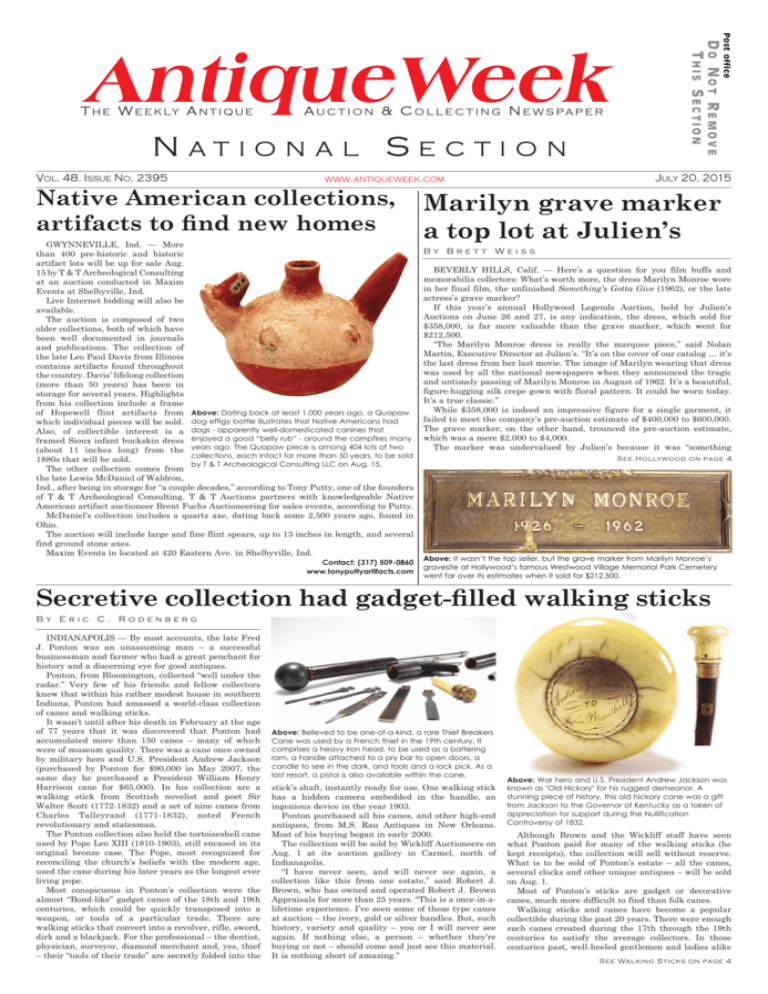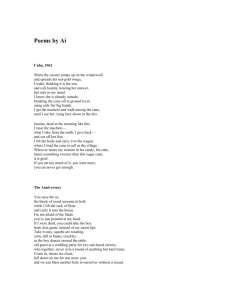AntiqueWeekcanes
advertisement

A u c t i o n & C o l l e c t i n g N e w s pa p e r Nation al Section Vol. 48. Issue No. 2395 July 20, 2015 www.antiqueweek.com Native American collections, artifacts to find new homes GWYNNEVILLE, Ind. — More than 400 pre-historic and historic artifact lots will be up for sale Aug. 15 by T & T Archeological Consulting at an auction conducted in Maxim Events at Shelbyville, Ind. Live Internet bidding will also be available. The auction is composed of two older collections, both of which have been well documented in journals and publications. The collection of the late Leo Paul Davis from Illinois contains artifacts found throughout the country. Davis’ lifelong collection (more than 50 years) has been in storage for several years. Highlights from his collection include a frame of Hopewell flint artifacts from Above: Dating back at least 1,000 years ago, a Quapaw which individual pieces will be sold. dog effigy bottle illustrates that Native Americans had Also, of collectible interest is a dogs - apparently well-domesticated canines that framed Sioux infant buckskin dress enjoyed a good “belly rub” - around the campfires many (about 11 inches long) from the years ago. The Quapaw piece is among 404 lots of two collections, each intact for more than 50 years, to be sold 1880s that will be sold. by T & T Archeological Consulting LLC on Aug. 15. The other collection comes from the late Lewis McDaniel of Waldron, Ind., after being in storage for “a couple decades,” according to Tony Putty, one of the founders of T & T Archeological Consulting. T & T Auctions partners with knowledgeable Native American artifact auctioneer Brent Fuchs Auctioneering for sales events, according to Putty. McDaniel’s collection includes a quartz axe, dating back some 2,500 years ago, found in Ohio. The auction will include large and fine flint spears, up to 13 inches in length, and several find ground stone axes. Maxim Events in located at 420 Eastern Ave. in Shelbyville, Ind. Contact: (317) 509-0860 www.tonyputtyartifacts.com Post office T h e W e e k ly A n t i q u e Do Not Remove This Section AntiqueWeek Marilyn grave marker a top lot at Julien’s By Brett Weiss BEVERLY HILLS, Calif. — Here’s a question for you film buffs and memorabilia collectors: What’s worth more, the dress Marilyn Monroe wore in her final film, the unfinished Something’s Gotta Give (1962), or the late actress’s grave marker? If this year’s annual Hollywood Legends Auction, held by Julien’s Auctions on June 26 and 27, is any indication, the dress, which sold for $358,000, is far more valuable than the grave marker, which went for $212,500. “The Marilyn Monroe dress is really the marquee piece,” said Nolan Martin, Executive Director at Julien’s. “It’s on the cover of our catalog … it’s the last dress from her last movie. The image of Marilyn wearing that dress was used by all the national newspapers when they announced the tragic and untimely passing of Marilyn Monroe in August of 1962. It’s a beautiful, figure-hugging silk crepe gown with floral pattern. It could be worn today. It’s a true classic.” While $358,000 is indeed an impressive figure for a single garment, it failed to meet the company’s pre-auction estimate of $400,000 to $600,000. The grave marker, on the other hand, trounced its pre-auction estimate, which was a mere $2,000 to $4,000. The marker was undervalued by Julien’s because it was “something See Hollywood on page 4 Above: It wasn’t the top seller, but the grave marker from Marilyn Monroe’s gravesite at Hollywood’s famous Westwood Village Memorial Park Cemetery went far over its estimates when it sold for $212,500. Secretive collection had gadget-filled walking sticks By Eric C. Rodenberg INDIANAPOLIS — By most accounts, the late Fred J. Ponton was an unassuming man – a successful businessman and farmer who had a great penchant for history and a discerning eye for good antiques. Ponton, from Bloomington, collected “well under the radar.” Very few of his friends and fellow collectors knew that within his rather modest house in southern Indiana, Ponton had amassed a world-class collection of canes and walking sticks. It wasn’t until after his death in February at the age of 77 years that it was discovered that Ponton had accumulated more than 150 canes – many of which were of museum quality. There was a cane once owned by military hero and U.S. President Andrew Jackson (purchased by Ponton for $90,000 in May 2007, the same day he purchased a President William Henry Harrison cane for $65,000). In his collection are a walking stick from Scottish novelist and poet Sir Walter Scott (1772-1832) and a set of nine canes from Charles Talleyrand (1771-1832), noted French revolutionary and statesman. The Ponton collection also held the tortoiseshell cane used by Pope Leo XIII (1810-1903), still encased in its original bronze case. The Pope, most recognized for reconciling the church’s beliefs with the modern age, used the cane during his later years as the longest ever living pope. Most conspicuous in Ponton’s collection were the almost “Bond-like” gadget canes of the 18th and 19th centuries, which could be quickly transposed into a weapon, or tools of a particular trade. There are walking sticks that convert into a revolver, rifle, sword, dirk and a blackjack. For the professional – the dentist, physician, surveyor, diamond merchant and, yes, thief – their “tools of their trade” are secretly folded into the Above: Believed to be one-of-a-kind, a rare Thief Breakers Cane was used by a French thief in the 19th century. It comprises a heavy iron head, to be used as a battering ram, a handle attached to a pry bar to open doors, a candle to see in the dark, and tools and a lock pick. As a last resort, a pistol is also available within the cane. stick’s shaft, instantly ready for use. One walking stick has a hidden camera embedded in the handle, an ingenious device in the year 1903. Ponton purchased all his canes, and other high-end antiques, from M.S. Rau Antiques in New Orleans. Most of his buying began in early 2000. The collection will be sold by Wickliff Auctioneers on Aug. 1 at its auction gallery in Carmel, north of Indianapolis. “I have never seen, and will never see again, a collection like this from one estate,” said Robert J. Brown, who has owned and operated Robert J. Brown Appraisals for more than 25 years. “This is a once-in-alifetime experience. I’ve seen some of these type canes at auction – the ivory, gold or silver handles. But, such history, variety and quality – you or I will never see again. If nothing else, a person – whether they’re buying or not – should come and just see this material. It is nothing short of amazing.” Above: War hero and U.S. President Andrew Jackson was known as "Old Hickory" for his rugged demeanor. A stunning piece of history, this old hickory cane was a gift from Jackson to the Governor of Kentucky as a token of appreciation for support during the Nullification Controversy of 1832. Although Brown and the Wickliff staff have seen what Ponton paid for many of the walking sticks (he kept receipts), the collection will sell without reserve. What is to be sold of Ponton’s estate – all the canes, several clocks and other unique antiques – will be sold on Aug. 1. Most of Ponton’s sticks are gadget or decorative canes, much more difficult to find than folk canes. Walking sticks and canes have become a popular collectible during the past 20 years. There were enough such canes created during the 17th through the 19th centuries to satisfy the average collectors. In those centuries past, well-heeled gentlemen and ladies alike See Walking Sticks on page 4 Page 4 – National Section Walking Sticks From Front Page were seldom seen without their walking sticks in hand. The sticks – usually boasting handles of precious metals and gems – were symbols of wealth, power and social standing. In the world of walking stick collecting, these canes are known as decorative sticks. These are the canes made of ivory, gold, silver, porcelain and jewels. They are made by artisans for customers who seek recognition and respect. At the other end of the spectrum are folk art canes. These are normally made of various types of wood, generally hand-carved – often elaborately from handle to tip. Folk canes have no metal tips, unlike the decorative canes, which may have metal tips measuring up to 6 or 7 inches to protect the cane from mud on unpaved roads. Whereas the decorative canes are carried to attract attention to the owner, folk canes, made by untrained artisans, reflect the attention more to the creator. The rarest – and most collectible canes, though – are the “gadget” (or system) canes. These canes often have crossover appeal. The “Ben Akiba” camera invented by Emil Kronke in 1903 is one of these crossover lots being sold by Wickliff. Still in working condition, the cane holds 18mm film measuring 28 inches long, allowing 24 photographs. It has a knob on the side of the cane handle that advances the film, with the shafting holding two empty rolls. The brass handle is finely engraved with a solid wooden shaft. Another cane with crossover appeal is the Thief Breakers Cane, dating back to the 19th century. “This unique cane is one-of-a-kind,” July 20, 2015 WWW.ANTIQUEWEEK.COM Originally from Antwerp, an extraordinary diamond merchant's cane will be sold at Wickliff's Aug. 1 Antique Cane Auction. Combining beauty and function, the cane breaks down to expose a scale, weights, tweezers and a secret diamond compartment. Bill Rau, owner of M.S. Rau Antiques, wrote Ponton. “It was made for a famous French thief. The top (head) is a weighted battery ram. The handle is attached to a crow bar to open doors, tool fits, lock pick, candle to see in the dark and a pistol if you get caught.” Another extraordinary cane is the Diamond Merchant’s Mother-of-Pearl cane. “One of the most important system canes in existence, this extraordinary and rare diamond merchant’s cane from Antwerp is accented with silver band and metal tip and diamond design mother-of-pearl inlay decoration, and scales, weights, tweezers and secret diamond compartment, 100 percent complete,” Rau wrote Ponton. The 35-inch cane was purchased by Ponton for $11,600. Another occupational cane is the Autopsy and Dissection Cane. “This is a very rare specialty cane made for doing an autopsy,” Rau wrote, “the cane separates into four compartments; first section contains a wooden pin holder with pins, the second contains six metal handheld instruments, the third contains a scalpel and straight razor, the fourth a test tube and roll of gauze.” Ponton bought the cane for $10,300. The auction includes several weapon canes. There are two Remington Hollywood From Front Page Marilyn never touched, never owned,” said Darren Julien, president and CEO of the auction house. “It was unique to the market, so we didn’t know what to expect. It was a little bit macabre … the news media gave it a lot of attention leading up to the auction.” If you’ve ever been to the Westwood Village Memorial Park Cemetery in Los Angeles, which is the resting place for a number of high profile celebrities, you probably saw Marilyn Monroe’s crypt, which is visited daily by fans and tourists who leave lipstick-smeared kisses on the grave marker. The marker that sold at auction is not that one. Rather, it is the old grave marker that was replaced decades ago by the current marker. According to Julien, the marker was sold by an employee of the morgue who worked there when the original was replaced in 1978. “It was a different time,” he said, “when those kinds of things weren’t worth as much as they are now. They just gave the grave marker to her.” Another Monroe item that sold for big bucks was a signed (by Hugh Hefner) edition of Playboy no. 1, featuring the blonde bombshell on the cover. It went for $87,500. While this wasn’t the highest price ever paid for a magazine (in 2007, for example, Sotheby’s took in $156,000 for an 1887 copy of Beeton’s Christmas Annual, featuring the first appearance of Sherlock Holmes and Dr. Watson), it is an astonishing sum for a periodical that once sold on newsstands for 50 cents a copy. A number of other celebrities were well-represented at the auction as well, including Marlon Brando, whose 1969 Harley Davidson commanded $256,000. Esther Williams’ 1969 Rolls-Royce Silver Shadow sold for $59,375 while film-used Rocky boxing gloves signed by Sylvester Stallone took in $34,375. Burgess Meredith’s Penguin costume from the Batman TV series brought $12,800 while Burt Reynolds’ trousers from Smokey and the Bandit II fetched $12,800. Other auction items include Sid Caesar’s Steinway Louis XV Grand Piano, $7,500; Dom DeLuise’s yellow gold and diamond Rolex, $8,960; Barbra Streisand’s Grammy Awards evening coat, $9,600; Tom Hanks’ Castaway ice skate and tooth necklace, $5,312.50; Liam Neeson’s Schindler’s List lapel pin, $2,812.50; and Hugh Jackman’s X-Men dog tag, $2,500. Trekkies bid on such desirables as a Starfleet duty tunic in the style of Spock, $42,240; a Starfleet duty Percussion Canes made by the Remington Arms Co. of Ilion, N.Y., between 1858 and 1861. Featuring the famous Remington dog head handle, only 278 were made before the company switched to manufacturing cartridge models. “This muzzle loader cane has a push button trigger and is covered in a protective plant resin called guttapercha,” according to Rau’s description. The ferrule is engraved with “J.F. Thomas, patent Feb’y 9 1858” with the serial number “119.” John F. Thomas was an inventor and master mechanic at the Remington factory and was granted many patents for his innovations.” Another unique weapon cane, featuring daggers and a gun, is the Indian Steel Rifle Cane. “This incredible cane is a perfect blend of beauty and functionality, made of expertly crafted blue steel and brass, cane houses a gun, a ram rod is also hidden in the lower section of the shaft that can be unscrewed to expose a dagger, the ferrule unscrews to expose another dagger, monogrammed on three areas on the shaft along with ‘342,’ ” according to Rau’s description. In addition to the 168 walking sticks, the sale includes several early elaborate clocks, a circa 1840 cased set of Bohemian dueling pistols, a circa 1820 rosewood Vienna regulator (a Blind Man’s Clock” tunic in the style of Captain Kirk, $57,600; and a “massive” Star Trek: The Original Series production script archive from Desilu Productions, $70,400. However, the focus of the auction clearly revolved around the legacy of Marilyn Monroe, with items ranging from rare photos by Joseph Jasgur and Andre de Dienes to movie props (including a chaise lounge from Let’s Make Love that brought in $56,250) to a variety of Monroe’s personal belongings, including a sterling silver compact, $25,600; a signed white glove, $16,250; brassiere cup liners, $10,625; a black velvet bustier, $8,960; and eyeliner pencils, $2,500. An inscribed drawing of a nude woman by Monroe sold for $75,000 while a side-view X-ray of the actress taken at Cedars of Lebanon Hospital brought in $12,500. “Marilyn Monroe transcends continents, transcends age groups,” Julien said, explaining the legend’s continued popularity and desirability more than half a century after her death. “She died while she was young and vibrant. She was larger than life. She was also a tragic figure, so people can relate to her. Our culture has elevated her as one of the great icons.” One key item that didn’t sell at the Hollywood Legends Auction was a 1969 orange Dodge Charger built and previously owned by John Schneider, who played Bo Duke and drove a similar car in The Dukes of Hazzard (CBS, 1979-1985). According to Julien, the reason the General Lee replica failed to draw bids was likely the recent controversy surrounding the Confederate flag, which is emblazoned on the roof of the car. “I can see both sides,” Julien said, referring to the banning of the Confederate flag by various companies and institutions. “I think it’s harmless – just part of the TV show – but for some people, the flag brings up bad memories of slavery in the South.” Overall, Julien is thrilled with the auction results, which tripled the company’s pre-auction estimates. “We anticipated $1 million in sales, but brought in $3 million,” Julien said. “The auction shows the strength of the market as more of a fine art market than just a memorabilia market. People are taking these types of items more seriously as an investment. And besides, it’s more fun to have Marilyn Monroe on display than stocks or bonds.” Holding enough film to surreptitiously shoot 24 photos, this 1903 cane has a knob on the side of the cane which advances the film. which strikes multi-tuned tones to designate every quarter hour upon request), two intricately carved chairs expressly made for Pope Leo III, and a circa 1860 “campaign chair” possibly used in battle by a cavalry officer. The campaign chair comes with its ironclamped box, painted “The Master of Sinclair/Royal Scots Greys” on the side. “It’s really strange, some of the items don’t really fit in with the collection,” Brown said. “But Mr. Ponton bought nothing but the best. And if he wanted it, he bought it. He apparently had the means … everything here will sell. Mr. Ponton apparently didn’t talk to his daughters much about the collection … they, or no one else, really knows the value of the collection … in reality, it doesn’t matter, all will be sold without reserve.” Contact: (317) 844-7253 www.wickliffauctioneers.com Above: Marilyn Monroe in the dress she wore for her last film, Something’s Gotta Give (1962). The floral garment sold in Julien’s recent Hollywood Legends Auction for $358,000. Below: John “Bo Duke” Schneider’s General Lee replica failed to garner any bids at the Hollywood Legends Auction. This is likely because of the recent controversy surrounding the Confederate flag.





